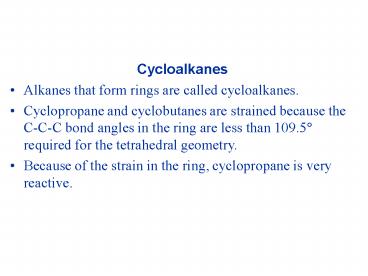Cycloalkanes - PowerPoint PPT Presentation
Title:
Cycloalkanes
Description:
Cycloalkanes Alkanes that form rings are called cycloalkanes. Cyclopropane and cyclobutanes are strained because the C-C-C bond angles in the ring are less than 109.5 ... – PowerPoint PPT presentation
Number of Views:95
Avg rating:3.0/5.0
Title: Cycloalkanes
1
- Cycloalkanes
- Alkanes that form rings are called cycloalkanes.
- Cyclopropane and cyclobutanes are strained
because the C-C-C bond angles in the ring are
less than 109.5? required for the tetrahedral
geometry. - Because of the strain in the ring, cyclopropane
is very reactive.
2
3
- Reactions of Alkanes
- The C-C and C-H bonds are very strong and
relatively nonpolar. Therefore, alkanes are very
unreactive. - At room temperature alkanes do not react with
acids, bases, or strong oxidizing agents. - Alkanes do combust in air (making them good
fuels) - 2C2H6(g) 7O2(g) ? 4CO2(g) 6H2O(l) ?H -2855
kJ - C2H6 O2 ? CO H2O (incomplete combustion)
4
- Substitution halogen atoms replace hydrogen
atoms (UV light is used to break Bonds) - CH4 X-X CH3X H-X
- step 1 initiation (formation of free radical
by homolytic fission) Cl2 ? 2 Cl. (by UV light) - step 2 - propagation
- Cl. CH4 ? CH3. HCl
- CH3. Cl2 ? CH3Cl Cl.
- step 3 termination
- Cl. Cl. ? Cl2
- Cl. CH3. ? CH3Cl
- CH3. CH3. ? C2H6
- Dehydrogenation H2 is removed, causing a CC
bond - CH3-CH3 CH2CH2 H2
5
Unsaturated Hydrocarbons
- Alkenes
- Alkenes contain C, H atoms and single and double
bonds. - The simplest alkenes are H2CCH2 (ethene) and
CH3CHCH2 (propene) - their trivial names are ethylene and propylene.
- Alkenes are named in the same way as alkanes with
the suffix -ene replacing the -ane in alkanes. - The location of the double bond is indicated by a
number.
6
- Geometrical isomers are possible since there is
no rotation about a CC ? bond. Geometrical
isomers have different physical properties. - Cis the same side
- Trans across
7
- Examples 1,2-dichloroethane
Cis mp 60.3ºC trans mp 47.5ºC
But-2-ene
cis mp -139ºC trans mp -106ºC
8
- Examples name the following
- 1.
- transpent-2-ene
- 2.
- 5-methyl-cis-hex-2-ene
9
- Alkynes
- Alkynes are hydrocarbons with one or more C?C
bond. Therefore, alkynes have one ? and two ?
bonds between two C atoms. - Ethyne (acetylene) is a reactive alkyne HC?CH.
- When acetylene is burned in the presence of
oxygen (oxyacetylene torch) the temperature is
about 3200 K. - Alkynes are named in the same way as alkenes with
the suffix -yne replacing the -ene for alkenes.
10
Unsaturated Hydrocarbons
- Addition Reactions of Alkenes and Alkynes
- The most dominant reaction for alkenes and
alkynes involves the addition of something
(hydrogen, halogen, water) to the two atoms which
form the double bond - Note that the C-C ? bond has been replaced by two
C-Br ? bonds. - Alkenes will react with bromine water by
addition, while alkanes will show no reaction
with bromine water. This is one way to
distinguish between alkanes and alkenes.
11
- A common addition reaction is hydrogenation
- CH3CHCHCH3 H2 ? CH3CH2CH2CH3
- Hydrogenation requires high temperatures and
pressures as well as the presence of a catalyst. - It is possible to cause hydrogen halides and
water to add across ? bonds - CH2CH2 HBr ? CH3CH2Br
- CH2CH2 H2O ? CH3CH2OH
12
- Mechanism of Addition Reactions
- Consider the reaction between 2-butene and HBr
- Careful kinetics experiments show the rate law to
be - Therefore, both 2-butene and HBr must be involved
in the rate determining step.
13
- From the kinetics data, we can propose the
following mechanism - The p-electrons in the alkene attack the d H
atom of the HBr to leave a positive charge on one
carbon (slow step)
14
- Then the pair of electrons on bromide attacks the
carbon with a positive charge to give the product.
15
- Polymers
- Polymers are large chains built from smaller
molecules (monomers) - Addition Polymerization (ex. polyethene)
- Initiation free radical is formed (species with
an odd electron) - Propagation happens over and over again chain
becomes very long
16
- Termination 2 radicals combine
- Economic Importance of alkene reactions
- Hydrogenation of vegetable oil used in the
manufacture of margarine. - Hydration of ethene used in the manufacture of
ethanol - Polymerization used in the manufacture of most
plastics.































